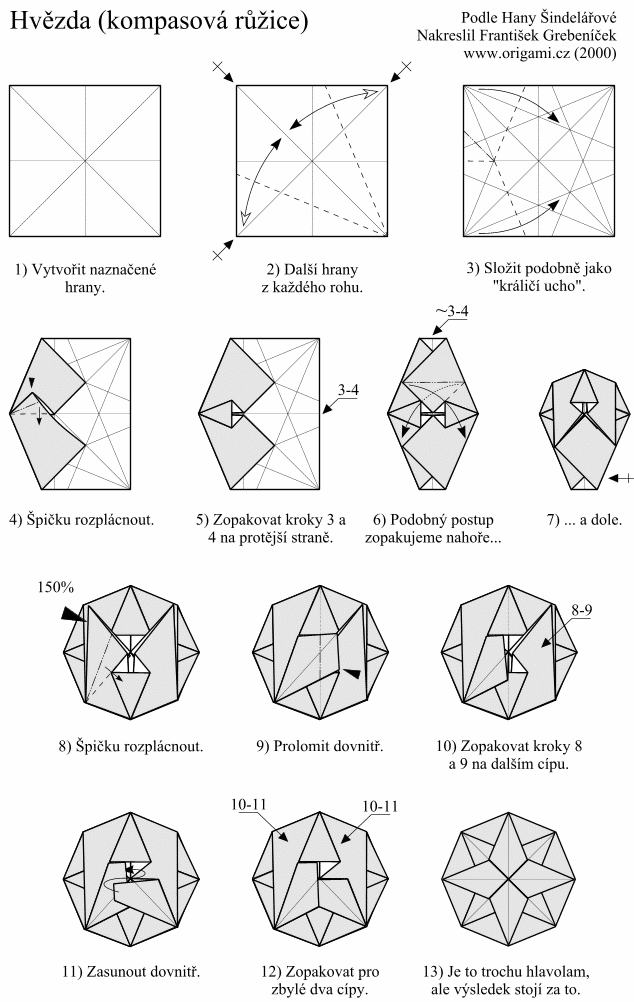

To finish the octahedron, you have to keep attaching units, always forming triangular pyramids in cycles of 4. The whole object will now bend into the third dimension. Use one Sonobe unit to connect the three pyramids, forming a fourth. Place three units together to form a triangular pyramid.īuild another pyramid connected to the first:įor an octahedron, there should always be cycles of four pyramids around a point. You must use the units that have an additional fold down the middle of the square.
#Modular origami diagrams how to
How to Make an Octahedron Out of 12 Sonobe Units This post/video shows how to make this origami cube in more detail. It should look like this before inserting the last unit:įinished cube. You should have 3 faces of the cube and one corner.Ĭontinue forming the cube. Now fold the squares together to form right angles and connect the units. Insert one Sonobe unit into the pockets of another unit: This post/video shows the process of making a Sonobe unit in more detail. When making the octahedron, or icosahedron you need to make an additional diagonal fold across the square part of the unit. There should be two triangular pockets that you can use to insert other units into. Tuck it into the bottom flap:įold the corners in to form a square.

Refold the top corner down along the previously formed crease. Fold the bottom flap up to meet the middle crease: Start by folding the top down to meet the crease in the middle:įold the bottom up to meet the crease in the middle:įold the bottom corner up to meet the upper crease: Now you are going to fold the paper in fourths. You should have a horizontal crease in the middle: If you are using colored origami paper, flip it so it is colored side down: This seems to be a good size for modular origami. This makes crease marks that I cut along to make 4 square sheets that are 4.25 inches on a side. I like using smaller paper so I usually fold in half vertically, and then horizontally. The square created above is 8.5 inches on a side. Take an ordinary piece of paper and fold it diagonally. If you need to make square paper, here is a fast way to do it. Paper (square origami paper is preferred as it folds much better)Īll of the instructions below assume square paper is being used.In the rest of this post we are going to learn how to make the Sonobe unit and each of these models. Below are a few models that are easy to make using this unit. The Sonobe unit is a simple example unit from modular origami that is both easy to fold and compatible for constructing a large variety of models. In modular origami, you combine multiple units folded from single pieces of paper into more complicated forms.
#Modular origami diagrams full
We’ll give you full credit and a link back to your website or social media accounts.Modular origami is a technique that can be used to build some pretty interesting and impressive models of mathematical objects. If you have diagrams of your own you’d like us to publish contact us here. So going forward this page will only contain diagrams I’ve directly uploaded to this website that I know will never go offline. It’s also caused a fair bit of drama over the years and I don’t really want to deal with that.
#Modular origami diagrams Offline
Also, once a site goes offline I can’t control what happens to those domains and some of these diagram links ended up going to questionable websites which I definitely don’t want. Every so often I’ve gone through and deleted the broken links which just makes this index smaller and smaller.

The main issue is over the years since I originally built this list a huge number of the websites have gone offline and many of the links are broken. Originally I wanted to create an easy index for people to find diagrams but ultimately this section has caused more problems than it’s worth. After much thought I’ve decided to retire this diagram database section.


 0 kommentar(er)
0 kommentar(er)
